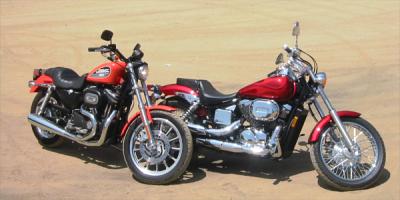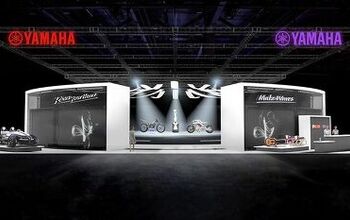
Even two's a crowd.
Torrance, California, August 26, 2002 --
Stonehenge. Do you know why the ancients built them? I don't. In fact, nobody really knows for sure why it was built. That's what a lot of people say about these cruisers. "Why'd you get a little Shadow? Didn't you know about the VTX?" You know, that sort of thing. But in all fairness, anything with two wheels is fun, isn't it? I mean, we had a blast riding scooters, that's for sure. And even anti-cruiser John slowly started warming up to the long-and-low set after riding both the Volusia and the Vulcan.
So what's up with these un-popular, off-the-wall tests?
Well, in the name of education, we'll do anything, even test these two old-timers. Let's be honest, at one point in time the Sportster was probably the best bike out there, period. Its history dates back as early as 1952 as the Model K "Sport," but for the most part, the Sportster that we know today didn't show up at dealers until 1986 with the spooning-in of an Evolution motor. Granted, in the modern age of Sportsters (post-1986), nobody in their right mind really thinks of Sportsters as being modern, high-performance transports. But they were always considered easy to ride, easy to learn on and most importantly, economical.
The Honda is no different, really, albeit its heritage is a bit leaner. First built in 2001, the Shadow Spirit 750 seemed to be aimed right at the heart of the lightweight cruiser niche. It's an important market, because the lightweights emphasize bang-for-buck over brute emotion to make the sale. For Harley-Davidson, the use of their 883 Sportster line to introduce riders to the brand is no secret. They'll lure them in with great price and economy, then dazzle them with aftermarket parts, or better yet, upgrade them into a Big Twin.
However, what if the customer just wants a bike? You know, something with two wheels that gets great mileage, decent performance and won't break the bank? Oh yea, its gotta look cool too.
For the most part, these two cruisers work great. Here we have two similar machines that are seemingly worlds apart. They both share certain design elements, namely, that they're cruisers and they're both V-twins. The Honda sports a somewhat modern, liquid-cooled, three-valve, dual-plug, V-twin motor. While the H-D's engine is the familiar air-cooled unit. However, in our top-o-the line, R spec 883 Sportster, it gets a much cooler black powder coating job versus the somewhat gaudy chrome laden air-pump on the Spirit.
"Stepping away from our two twins, you'll notice that the Honda has an uncharacteristically pretty paint job with dark red flames on a lighter red background."
The thing that really got to us was that it really did look good.
However, the intense amount of chrome that was found on the Honda left a lot of onlookers covering their eyes. The Harley, being a Harley after all, always seemed to steal the show. We think it might have to do with its bright orange flat-track inspired coverings, combined with its flat-black engine and steering gear, the 883R really turned heads. Riding the machines left little to the imagination. These little cruisers aren't gonna win any real-world performance or comfort contests. But in their defense, they compare well to other cruisers. Just looking at the weight and seat-height values for these machines will leave many "strength" or "vertically-challenged" riders breathing a sigh of relief. For example, the Shadow Spirit weighs a manufacturer's listed 496 pounds dry with a 26.6 inch seat height. Whereas the 883 R sports (no pun intended) a manufacturer's listed 503 pounds dry with a 28-inch seat height.
"The Sportster, true to its name, proved sportier than the Spirit did."
With such friendly seat-heights, you'd think more thought would've been placed into the ergonomics of each machine. However, after 45 minutes of freeway riding, we wanted to take a large planer -- or at the very least a moderate sized belt-sander -- to the Los Angeles freeway system. The Spirit Shadow 750 had softish springs both front and back and damping rates that could use some stiffening. While appropriate for a light-weight rider (say, below 175 pounds) on slower city roads, once highway speeds get thrown into the mix, all bets were off; the damping just couldn't keep up.
The Sportster, true to its name, proved sportier than the Spirit did, although it too was plagued with soft fork and springs. Its damping was just a bit better. Sort of like comparing apples to, well, bigger apples. Unfortunately, a problem that beset both vehicles was the dreaded lower-back pain that seem to be problem-most-foul. The consensus seemed to indicate that the slouched seating position bent the spine in such a manner as to best allow shocks to go straight through the spinal column and into the brain.
While the rider of either machine enjoyed what, during the Spanish Inquisition, could be conceived as comfort for periods longer than 45-minutes, passengers, well... let's just say people of the sadomasochistic persuasion will feel right at home. We shouldn't really have to say it but the Sportster's rear seat sucked. Just look at the thing, does it look comfortable to you? As soon as a passenger would sit on that crude lump, they would immediately slide back and hit the license plate frame. I mean really, did some committee really sit down and decide that this would be the best way to transport a passenger? As a better option, the stock 883 does away with the passenger seat altogether.

Motorcycle.com presents an unrivaled combination of bike reviews and news written by industry experts
More by Motorcycle.com Staff






























Comments
Join the conversation